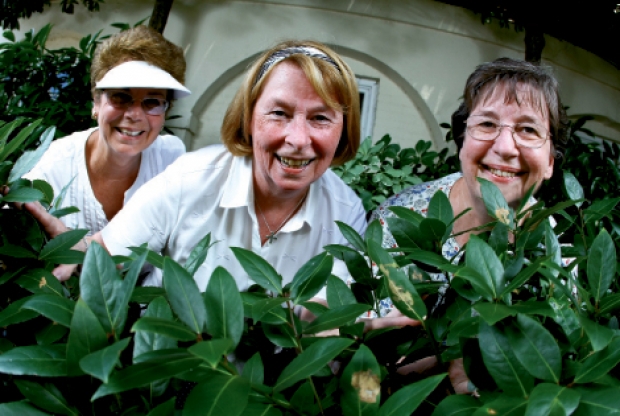Herbal Essences: Tucked into the historic streets of Georgetown, a well-trod path reveals a secret garden

In a city that pre-dates the Revolutionary War, Georgetown hides its historic district from drivers whizzing by on heavily traveled U.S. 17. The thirty-two blocks of the Historic District date back to 1729, and are filled with Colonial and antebellum homes (some turned bed-and-breakfasts), and a centuries-old waterfront complete with a bustling restaurant trade, fishing charters, ice-cream shops, bookstores, antique stores, and a 165-year-old town clock ticking atop its tower along the north end of Front Street.
A small pathway leads pedestrians beside the clock tower, also home of the Rice Museum, to the start of the Harborwalk at the riverfront. On both sides of that twenty-yard pathway, mint, bay, sage, germander, lavender, patchouli, fennel, and a dozen other herbs grow and are lovingly tended by the Low Country Herb Society. Local restaurants and herb society members (and occasional passersby) pick and use these herbs at will, and that’s perfectly okay with the organization that plants and maintains these leafy little wonders. In fact, it’s part of their mandate.
I crushed a small chocolate-mint leaf, marveling at its fresh aroma. (An herb garden is nature’s scratch ‘n’ sniff.) “A lot of people stop to pinch and smell,” says Janelle Sabourin, the society’s chairman of the herb garden committee. We wandered along the curving path between buildings and admired the handiwork of the society, which got its start in 1986 at Brookgreen Gardens in Murrells Inlet. “Filtered and morning sun are best,” notes Sabourin. “This year some things didn’t do so well because of an [unusually] cold, wet winter; and others did better.” The society eventually moved its garden to Georgetown, where it’s been blooming ever since.
The current roster of members meets monthly, September through May, at St. Paul’s Waccamaw United Methodist Church in Litchfield. “The public is welcome,” mentions Beth Eisenberg, a former president and treasurer. Attendance at the monthly meetings often swells to include nonmember guests who visit to see cooking demonstrations and listen to speakers offer tidbits on gardening, cooking, or historical herb uses.
Herbs have been used for centuries and are referenced in the earliest known written texts. Chinese herbal medicine is more popular today than when it was first practiced around 9,500 BC. The first pharmacopeias were filled with herbal remedies still in use today. Alternative medicine is a $34 billion industry. St. John’s Wort has been declared an effective treatment for mild to moderate depression, and peppermint, a natural stimulant, is excellent in ice cream, tea, and chewing gum.
“Our members have a lot of reasons for joining,” adds Susan Rivenburgh, the society’s current president. “I live in a condo and don’t really have the space for a garden, so this benefits me in that way. Our programs are geared toward providing some education and information regarding gardening or herbs in general, or even natural products and remedies. I originally became interested because of my Crohn’s Disease. I wanted to find ways to flavor food that didn’t cause me problems. We have people who come sometimes just for one meeting because the specific program that month interests them. Some join just to get our newsletter.”
An annual sale is held every April at the Inlet Culinary Garden in Murrells Inlet. “We bring samples of things cooked with herbs,” says Eisenberg, “crackers, dips, all kinds of things.” A portion of the day’s receipts from the Inlet Culinary Garden is donated to the organization.
Herb growing and cultivating is a year-round activity, and there’s always something to be sampled at the Georgetown herb garden, during spring, summer, fall—even in the dead of winter. But don’t look for a Web site—the society doesn’t have one. They’re simply too busy planting, maintaining, and enjoying nature’s bounty. Still, they must be doing something right, with 2011 the year of their twenty-fifth anniversary.
After strolling through the garden’s fragrant green, my guess is that much of the group’s pleasure comes from simply pinching, sniffing, sampling, and savoring. Stop by the garden for a sample and ask any local chef who may be wandering through what’s for dinner.